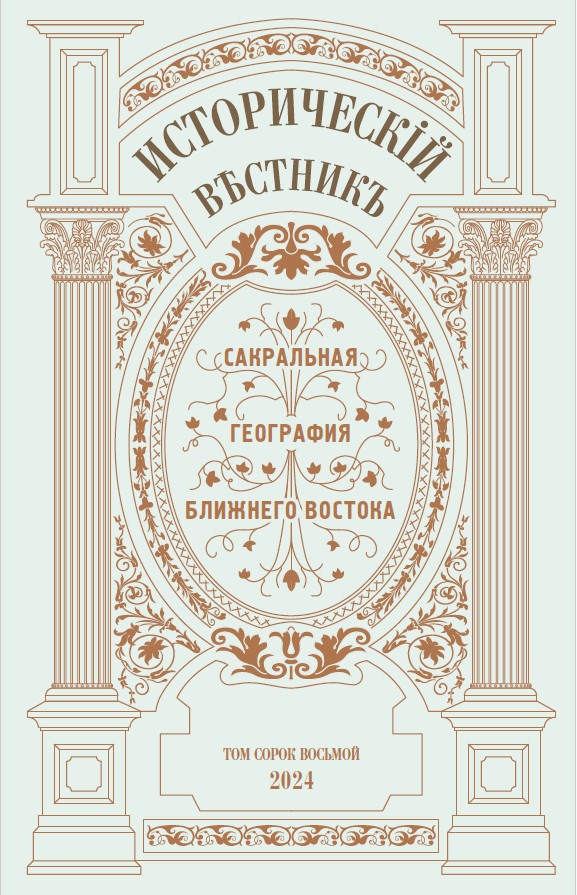
Якушев М.И. Сакральное пространство Св. Софии в восприятии европейских художников
DOI: 10.35549/HR.2024.2024.48.013Якушев М.И. Сакральное пространство Св. Софии в восприятии европейских художников // Исторический вестник. 2024. Т. XLVIII. С. 304–327.
Аннотация
В статье рассказывается об истории храма Святой Софии, пережившей несколько периодов в своей истории: византийский, латинский, вновь византийский, османский и турецкий. Падение Константинополя и обращение Софийского храма в главную мечеть османских султанов положил конец его посещению христианскими паломниками и путешественниками, изменил ее внешний и внутренний облик, который до 2-й пол. XVII в. оставался неизвестным для европейцев.
С появлением первого художника и путешественника внутри мечети в 1672 г. дало представление о том, как изменился и менялся ее облик в результате предпринимаемых султанами шагов по исламизации внутреннего и внешнего убранства мечети. В результате в середине 2-й половине XVIII в. Айя София практически полностью приобрела вид традиционной мечети. После реставрации Гаспара Фоссати (1847-1849 гг.,) Софийская мечеть частично вернула себе прежний византийский облик. В изданный альбом цветных литографий с изображениями Софийской мечети Фоссати включил акварели с ее видами до и после капитального ремонта.
Благодаря работам европейских художников у современного зрителя и читателя есть возможность проследить динамику изменения облика мечети в сторону еще большего омечетивания и частичного возвращения ей утраченного византийского облика, когда Айя София превратилась из действующей соборной мечети в государственный музей в 1935 г.
Ключевые слова: Церковь Святая София, мечеть Айя София, султан, архитектор, художник.
Якушев Михаил Ильич – кандидат исторических наук, Генеральный директор аналитического центра «Катехон», старший научный сотрудник Института Востоковедения РАН.
***
Yakushev M.I. The Sacred Space of Hagia Sophia / Aya-Sofia in the Perception of European Artists // Historical Reporter. 2024. Vol. 48. P. 304–327.
Abstract
The article tells about the history of the Church of Hagia Sophia, which has gone through several periods: Byzantine, Latin, Byzantine again, Ottoman and Turkish. The fall of Constantinople and the conversion of Hagia Sophia Church into the principal mosque of the Ottoman sultans put an end to its visits by Christian pilgrims and travellers, changed its appearance and internal view, which remained unknown to Europeans until the 2nd half of the 17 century.
With the appearance of the first artist and traveler inside the mosque in 1672, it gave an idea of how its view had changed and changed as a result of the efforts taken by the sultans to Islamize the interior and exterior view of Aya-Sofia Mosque. As a result, in the middle of the 2nd half of the 18 century Hagia Sophia almost completely acquired the appearance of a traditional mosque. After the restoration of Gaspar Fossati (1847-1849), the Aya-Sofia Mosque partially regained its former Byzantine appearance. In the published album of color lithographs with images of the Sofia Mosque, Fossati included watercolours with its views before and after major repairs.
Thanks to the works of European artists, the modern viewer and reader have the opportunity to trace the dynamics of the change in the appearance of the mosque towards even greater marking and partial restoration of its lost Byzantine appearance, when Aya-Sofia turned in 1935 from an acting mosque into a state museum.
Key Words: Hagia Sophia Church, Aya Sofia Mosque, Sultan, Architect, Artist, Painter.
Mikhail I. Yakushev – Ph.D. in History, Senior, Director General of the Analytic Center «Katehon», Senior Research Fellow at the Institute of Oriental Studies, Russian Academy of Sciences, Moscow, Russia.
***
References
- Begleri G.P. Sophia. The tidings of the Russian archaeological institute in Constantinople. Vol. VIII, issue 1-2. Sofia: Drzhavna pecha, 1903. P. 117.
- Bobrov Yu.G. From the history of the disclosure of mosaics of the Church of St. Sofia in Constantinople // Monuments of culture. New discoveries. Writing’, art, archaeology. Yearbook 1980. Leningrad, 1981. P. 393—399.
- Bobrov Yu.G. The forgotten role of Russia in the discovery of the mosaics of the Hagia Sophia in Constantinople / Russian Art. № 1 (69). 2021. M., 2021. P. 126—133.
- Fossati G. Aya Sofia, Constantinople, as recently restored by order of H.M. the sultan Abdul Medjid / from the original drawings by Chevalier Gaspard Fossati; lithographed by Louis Haghe, esq. Discription Historique de Planches de Ste. Sophie by Adalbert de Beaumont. London, 1852. Planchets № 3, 4, 9, 24.
- Majeska G.P. The Birth of Ignatius Smolyanin // Russian travelers in Constantinople in the fourteenth and fifteenth centuries. Washington, 1984. P. 92, 207–208.
- Murav’ev A.N. Letters from the Orient (from 1849 till 1850). Part I. Moscow: Ihtios, 2005. P. 10–11.
- Polenov V. In the choirs of the Church of Sophia in Constantinople (Istanbul). 1882. Tretyakov Gallery, 1885. Inv. 2793.
- Preziosi Amadeo. «Refugees in the Gallery of the Mosque of Hagia Sophia» <https://www.flickr.com/photos/gandalfsgallery/15435217082/sizes/k/>.
- Sakharov I.P. The Tales of the Russian people. Vol. II. St. Petersburg, 1849. Vol. VIII. P. 51.
- Savvaitov P. The Travel of Archbishop Anthony of Novgorod to Tzar’grad at the end of the XII century. St. Petersburg, 1872. P. 85–86.
- Vinogradov A.Yu., Zakharova A.V., Chernoglazov D.A. The Church of St. Sophia of Constantinople in the light of Byzantine sources. St. Petersburg: Publishing house «Pushkin House», 2018. P. 22.

